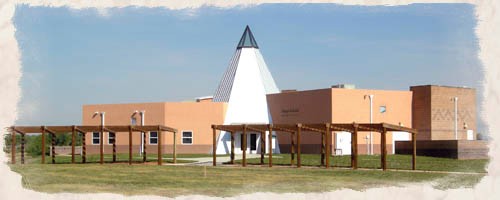Fort Sumner State Monument and Bosque Redondo Memorial
Introduction
Text-to-speech Audio
Fort Sumner was the center of a million-acre reservation known as the Bosque Redondo Indian Reservation. The story of how the U.S. Army forcibly moved the Navajo and Mescalero Apache people from their traditional homelands to the land surrounding this lonely outpost is pivotal to the history of the American West.
During this tragic period of U.S. history, the Mescalero Apache were rounded up from their homes in the Sacramento Mountains and brought to Bosque Redondo in early 1863. The Navajo were starved into submission and also forced to march hundreds of miles to the Reservation. The Navajo call this journey the Long Walk, over 50 different groups made the trek over a period of nearly three years. Four different routes were used, based on the weather, water and rations available along the way.
Several hundred of the Navajo captives died during the walk and some were abducted by slave traders along the way. No housing was provided for them, the Navajo lived in pits covered by tree branches and hides, the Mescalero had teepees and wickiups. Food was almost always in short supply as the army had no real idea of how many Navajo to expect; only about 3000 had been anticipated.
Over 8,500 Navajo and nearly 500 Mescalero Apache were spread along the banks of the Pecos River within the Bosque Redondo. The Army put them to work, building the fort, planting cottonwood trees, digging ditches, plowing, and building a diversion dam. The intent was to teach the Indians how to farm so that they would be self-sufficient and be able to feed themselves.
This experiment in social engineering was doomed to failure from the beginning. The Mescalero Apaches— nearly 500 strong—left in the middle of the night during February of 1865. They were not farmers and in fact believed that farming damaged mother earth. They also felt betrayed as they had been told that they would only need to be at Bosque Redondo a few months. To show their intent to be peaceful before they would be allowed to return to live in their beautiful mountain homeland.
A few who could not travel fast, were left behind to keep the camp fires burning so the soldiers would not know they had gone.
The Navajo were held for three more years before the Government resolved to undo this terrible mistake. General William T. Sherman was sent to Fort Sumner in May of 1868 to investigate reports of mistreatment of the Navajo.
He found conditions to be as they were reported and offered Navajo leaders an expense paid trip to Oklahoma to see what life there would be like, they declined his offer and asked to be allowed to go home. Sherman and the Navajo Headmen entered into negotiations that resulted in the Treaty of 1868 that allowed the Navajo to return to their homelands in the Four Corners Region and the treaty also acknowledged Navajo sovereignty.
Today a unique new museum designed by Navajo architect David Sloan--shaped like a hogan and a tepee--and an interpretive trail, provide information about the tragic history of Fort Sumner and Bosque Redondo Indian Reservation. The museum awaits the development of its permanent exhibit which will tell the story of the Native people who were forced to live at Bosque Redondo.
Images

Backstory and Context
Text-to-speech Audio
Set in the scenic Pecos River valley on the site of the old fort, this Historic Site is a beautiful destination to visit and reflect on the history and the suffering of people forced away from their homes. The site is enhanced by Memorials to the Mescalero and the Navajo, a small flock of Churro sheep as were owned by the Indians at the time and a planned peach orchard, planted with seeds from Canyon De Chelly.
